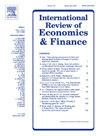Extreme downside shocks in international financial markets: transmission boundaries and typical events
IF 5.6
2区 经济学
Q1 BUSINESS, FINANCE
引用次数: 0
Abstract
Extreme downside shocks lead to significant harm within financial markets, thereby threatening global economic stability. To investigate the cross-market transmission of extreme downside shocks and their heterogeneity, this paper extends the sectional multivariate extreme value copula (SMEVC) for empirical analysis across major international financial markets. The “boundary effect” of extreme downside shocks is uncovered, along with the quantification of the “co-movement effect” and “mutual triggering effect” across markets. The findings indicate that extreme downside shocks transmitted through strongly connected markets tend to fall within a narrower range, whereas those in weakly connected markets are more widely dispersed. Furthermore, extreme downside shocks reveal a stronger “co-movement effect” within intraregional markets, generating distinct regional connections, especially in Europe. Meanwhile, the U.S. market exhibits a notable “co-movement effect” with markets across different regions. Finally, adverse economic events generate stronger and more transmissible extreme downside shocks, whereas political events and natural disasters have a more limited impact. In contrast, public health crises such as COVID-19 prompt severe global shocks. This paper offers new insights into financial risk management and policymaking, emphasizing the importance of mitigating extreme downside shocks across markets in a globally integrated economy.
国际金融市场极端下行冲击:传导边界与典型事件
极端的下行冲击会对金融市场造成重大伤害,从而威胁到全球经济稳定。为了研究极端下行冲击的跨市场传导及其异质性,本文将截面多元极值联结法(sectional multivariate extreme value copula, SMEVC)扩展到主要国际金融市场进行实证分析。揭示了极端下行冲击的“边界效应”,并量化了跨市场的“共动效应”和“互触发效应”。研究结果表明,通过强连接市场传播的极端下行冲击往往落在一个较小的范围内,而在弱连接市场中传播的极端下行冲击则更为分散。此外,极端的下行冲击揭示了区域内市场更强的“联合运动效应”,产生了明显的区域联系,尤其是在欧洲。与此同时,美国市场与不同地区的市场表现出显著的“联合运动效应”。最后,不利的经济事件会产生更强、更具传染性的极端下行冲击,而政治事件和自然灾害的影响则更为有限。相比之下,COVID-19等公共卫生危机会引发严重的全球冲击。本文为金融风险管理和政策制定提供了新的见解,强调了在全球一体化经济中减轻各市场极端下行冲击的重要性。
本文章由计算机程序翻译,如有差异,请以英文原文为准。
求助全文
约1分钟内获得全文
求助全文
来源期刊
CiteScore
7.30
自引率
2.20%
发文量
253
期刊介绍:
The International Review of Economics & Finance (IREF) is a scholarly journal devoted to the publication of high quality theoretical and empirical articles in all areas of international economics, macroeconomics and financial economics. Contributions that facilitate the communications between the real and the financial sectors of the economy are of particular interest.

 求助内容:
求助内容: 应助结果提醒方式:
应助结果提醒方式:


